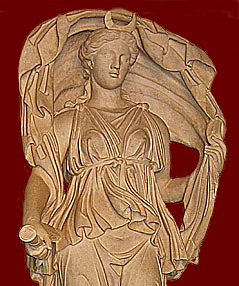
Diana-Selene. 1st century CE
Roman copy of 4th century BCE original
The Roman goddess Diana evolved from an Italian moon goddess who was associated by the ancients with the Greek divinity Artemis and worshipped by the Latin League. Liminal and multiple in character and powers, Diana was worshipped particularly but not exclusively by women for her protection of prepubescent youths, the labor of birthing, and young children. Her importance to the Romans is evidenced by three famous cult sites: at Mt. Tifata near the Greek colony of Capua, in Aricia on the shore of the volcanic lake near Nemi, and on the Aventine Hill outside the early pomerium of Rome, in the temple traditionally built for her by the sixth King of Rome (578-535) Servius Tullius (Diana's sanctuaries). In a poem that departs from his Lesbia corpus in formality of content and solemnity of tone, Catullus honors the benefactions and sanctity of the virginal daughter of Leto and Jupiter. The "Hymn to Diana" celebrates through petition and epithet the goddess's wide dominion over wilderness, procreation, darkness and light, and the cultivated land. The poem focuses on Diana without reference to her twin brother Apollo* or to the myths of punishment (Actaeon*, Niobe*) associated with the Greek goddess Artemis or even to her identity as divine huntress* and Mistress of the Beasts* (Potnia Theron). In addition, the poem evokes the Roman divinities Lucina, Trivia, and Luna in place of the Greek Eileithyia, Hecate, and Selene. Whether the poem was written for a performance in honor of the goddess is contested, but its public and choric nature is undeniable, as the opening stanza identifies the singers as a chorus of pueri integri puellaeque (unblemished boys and girls), and the closing stanza functions as a prayer addressed to the goddess on behalf of the whole Roman people. The poem is 24 verses long, divided into six 4-line stanzas in Greek lyric meter: each stanza is composed of 3 lines of Glyconic meter with a final verse in Pherecratic (poem scanned). For further information about the goddess and her worship see C.M.C. Green in the Bibliography.
puellae et pueri integri:
Dianam pueri integri
puellaeque canamus.
10silvarumque virentium
tu Lucina dolentibus
15tu potens Trivia et notho es
dicta lumine Luna.
rustica agricolae bonis
Click on the underlined words for translation aids and commentary, which will appear in a small window. Click on the icon link
![]() to the right of the
poem for related images and information.
to the right of the
poem for related images and information.
*Images linked with generous permission from theoi.com.